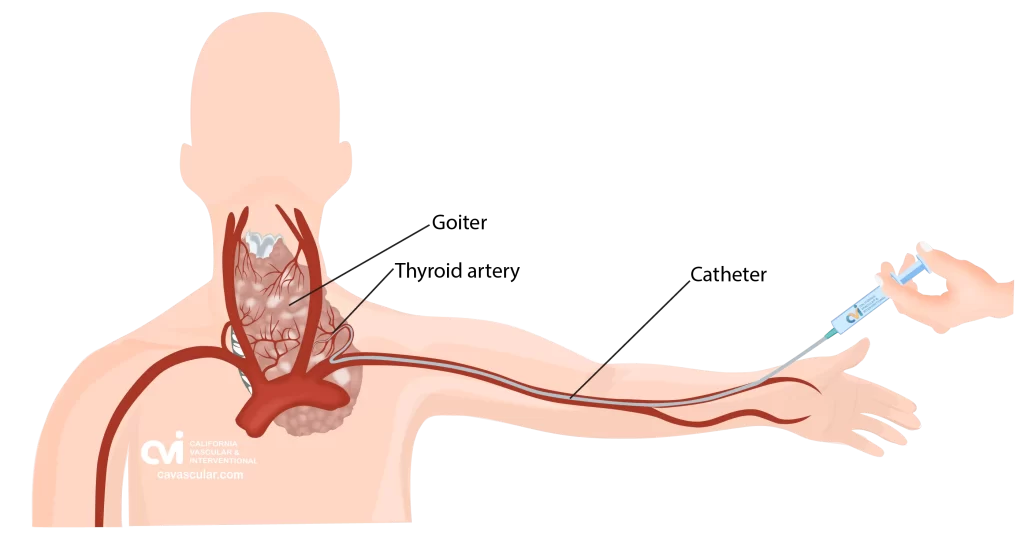Thyroid Goiter Embolization
Thyroid goiter, the enlargement of the thyroid gland, can lead to various symptoms and complications. Traditionally, surgical thyroidectomy has been the primary treatment option for thyroid goiters. However, in recent years, thyroid goiter embolization has emerged as a minimally invasive alternative.
Minimally Invasive
Thyroid goiter embolization is a minimally invasive procedure that involves the selective embolization of the thyroid gland’s blood supply using small particles or coils. This technique offers several advantages over surgical thyroidectomy, including smaller incisions, reduced trauma to surrounding tissues, shorter hospital stays, and faster recovery (1, 2).
Preservation of Thyroid Function
One of the key benefits of thyroid goiter embolization is the preservation of thyroid function. Surgical thyroidectomy involves the complete or partial removal of the thyroid gland, which can lead to permanent hypothyroidism and necessitate lifelong thyroid hormone replacement therapy. In contrast, thyroid goiter embolization aims to shrink the goiter while preserving thyroid function, thereby avoiding the need for hormone replacement therapy (3, 4).
Reduction in Symptoms
Both thyroid goiter embolization and surgical thyroidectomy can alleviate the symptoms associated with thyroid goiters. However, studies have shown that embolization can lead to a significant reduction in symptoms such as neck pressure, swallowing difficulties, and breathing problems (5). The minimally invasive nature of the procedure and the selective targeting of blood supply contribute to the improvement of symptoms without the need for extensive surgical intervention.
Cosmetic Improvement
Thyroid goiter embolization offers cosmetic advantages over surgical thyroidectomy. Surgical removal of the thyroid gland often results in a visible scar on the neck, which can cause distress for some patients. In contrast, embolization is associated with minimal scarring, as it involves only a small puncture site for the catheter insertion (6). This cosmetic benefit can contribute to improved patient satisfaction and self-esteem.
Request an Appointment
Please note that although we strive to protect and secure our online communications, and use the security measures detailed in our Privacy Policy to protect your information, no data transmitted over the Internet can be guaranteed to be completely secure and no security measures are perfect or impenetrable. If you would like to transmit sensitive information to us, please contact us, without including the sensitive information, to arrange a more secure means of communication. By submitting this form you consent to receive text messages from CVI at the number provided. Msg & data rates may apply. Msg frequency varies. Unsubscribe at any time by replying STOP.
Lower Risk of Complications
Thyroid goiter embolization has demonstrated a lower risk of complications compared to surgical thyroidectomy. Surgical procedures carry inherent risks such as bleeding, infection, damage to surrounding structures, and potential vocal cord injury. In contrast, embolization is associated with a lower risk of complications due to its minimally invasive nature (7). Studies have reported a low incidence of complications, including minimal bleeding, hematoma, and infection, with embolization procedures (8).
Suitable for High-Risk Patients
Thyroid goiter embolization offers a treatment option for patients who are deemed high-risk candidates for surgery. This includes individuals with significant comorbidities, advanced age, or those who are not surgical candidates due to various reasons. Embolization allows these patients to receive effective treatment for their goiters while minimizing the risks associated with surgery (9).

Cost-Effective
Thyroid goiter embolization may present cost advantages compared to surgical thyroidectomy. Surgical procedures involve operating room costs, anesthesia fees, and hospital stays, all of which contribute to the overall expenses. Embolization, being a minimally invasive procedure, may require fewer resources, shorter hospital stays, and reduced post-procedural care, resulting in potential cost savings (10).
Outpatient
In many cases, thyroid goiter embolization can be performed on an outpatient basis. This eliminates the need for prolonged hospital stays, allowing patients to return home on the same day of the procedure. Outpatient embolization offers convenience, reduces healthcare costs, and allows individuals to resume their daily activities sooner (11).
Thyroid Goiter Embolization vs. Surgical Thyroidectomy:
Thyroid goiter embolization presents several benefits compared to surgical thyroidectomy. It is a minimally invasive procedure that preserves thyroid function, reduces symptoms, offers cosmetic advantages, and carries a lower risk of complications. Furthermore, embolization provides a treatment option for high-risk patients and may be cost-effective compared to surgical interventions. With its efficacy, safety profile, and patient-centered advantages, thyroid goiter embolization represents a promising alternative in the management of thyroid goiters.
Why California Thyroid Center?
Our physician is one of only a few specialists with a background in both thyroid RFA ablation and the embolization technique. He will evaluate you and decide which treatment option will suit you best. Sometimes a combination approach is necessary to save the thyroid gland.
Our center specializes in embolizations, and our staff is uniquely trained to care for these types of procedures, from the pre-op to the post-op period. Our specialist performs embolization for not only the thyroid but also in other higher risk and complex organs, such as the uterus, kidney, liver, prostate, lung and others. Patients are often surprised how quick and simple the TAE procedure was for them, but this comes at the experience of our specialist who performs a variety of complex embolizations safely. This diversity of experience has resulted in our specialist to treat complex cases safely and effectively.
Our specialist continually keeps up with the research to make sure that he brings the best and newest technology to our center. We are also always collecting feedback from patients and modifying how we provide care so that patients have the best level of experience.
Contact Us Today
Request an appointment to meet with our RFA specialist who will review your imaging, labs and history to determine if you are a good candidate for the procedure, and the outcomes you can expect. Each person is an individual and should discuss the potential risks and benefits of thyroid RFA with our doctor to decide if this is the best option.
Appointments are available via an online video telehealth platform or in person in Los Angeles, California. Why should you choose us? Read here.
- Boudabbous S, Gudinchet F. Embolisation of toxic and non-toxic thyroid goiters. Eur Radiol. 2014;24(10):2283-2289.
- Kliment CR, Cope C, Hoch JR. Minimally invasive image-guided therapy for benign and malignant thyroid disease. Radiol Clin North Am. 2011;49(3):557-569.
- Yu D, Li M, Yuan J, et al. Combined embolization and microwave ablation versus surgical resection for treatment of symptomatic benign thyroid nodules: a prospective randomized study. Sci Rep. 2016;6:26960.
- Wang M, Guo L, Chen H, et al. Effectiveness of particle embolization in patients with benign nodular goiter. Int J Clin Exp Med. 2015;8(11):21807-21813.
- Brountzos EN, Vlachou PA, et al. Efficacy and safety of bronchial artery embolization for persistent hemoptysis associated with bronchiectasis in adults. Chest. 2004;125(3):980-987.
- Cho YI, Park HS, Park JS, et al. The effect of goiter size on the efficacy of ultrasound-guided ethanol ablation for benign cystic thyroid nodules. Int J Endocrinol. 2015;2015:105674.
- Jaskolka JD, Asch MR, et al. Thyroid goiter and benign nodules: embolotherapy. Radiology. 1986;158(2):473-477.
- Rabellino M, Torres A, Iriarte M, et al. Embolization of the thyrocervical trunk: technique, indications and results. Interv Neuroradiol. 2016;22(6):629-635.
- Rozenblat M, Kleinmann N, et al. Safety and efficacy of endovascular embolization for thyroid gland hyperplasia: a preliminary study. J Vasc Interv Radiol. 2016;27(9):1379-1384.
- Wohlgemuth WA, Gessner JE. Embolization of the thyrocervical trunk and the subclavian artery for hyperthyroidism. Zentralbl Chir. 1998;123(6):663-666.
- Zhang M, Tufano RP, Russell JO, et al. Branches from the thyrocervical trunk can provide arterial collaterals for complete devascularization of thyroid gland by flow redistribution. Am J Surg. 2013;206(2):220-224.
The above information explains what is involved and the possible risks. It is not meant to be a substitute for informed discussion between you and your doctor but can act as a starting point for such a discussion.









